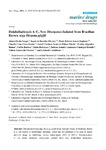Mostrar el registro sencillo del ítem
Dolabelladienols A–C, New Diterpenes Isolated from Brazilian Brown Alga Dictyota pfaffii
| dc.contributor.author | Pardo-Vargas, Alonso | |
| dc.contributor.author | Barcelos Oliveira, Ingrid de | |
| dc.contributor.author | Stephens, Paulo Roberto Soares | |
| dc.contributor.author | Cirne-Santos, Claudio Cesar | |
| dc.contributor.author | Palmer Paixão, Izabel Christina Nunes de | |
| dc.contributor.author | Ramos, Freddy Alejandro | |
| dc.contributor.author | Jiménez, Carlos | |
| dc.contributor.author | Rodríguez, Jaime | |
| dc.contributor.author | Resende, Jackson Antonio Lamounier Camargos | |
| dc.contributor.author | Teixeira, Valeria Laneuville | |
| dc.contributor.author | Castellanos, Leonardo | |
| dc.date | 2014 | |
| dc.date.accessioned | 2017-09-26T09:01:33Z | |
| dc.date.available | 2017-09-26T09:01:33Z | |
| dc.date.issued | 2014 | |
| dc.identifier.citation | Pardo-Vargas, A.; de Barcelos Oliveira, I.; Stephens, P.R.S.; Cirne-Santos, C.C.; de Palmer Paixão, I.C.N.; Ramos, F.A.; Jiménez, C.; Rodríguez, J.; Resende, J.A.L.C.; Teixeira, V.L.; Castellanos, L. Dolabelladienols A–C, New Diterpenes Isolated from Brazilian Brown Alga Dictyota pfaffii. Mar. Drugs 2014, 12, 4247-4259. | es_ES |
| dc.identifier.issn | 1660-3397 | |
| dc.identifier.uri | http://hdl.handle.net/2183/19532 | |
| dc.description.abstract | [Abstract:]The marine brown alga Dictyota pfaffii from Atol das Rocas, in Northeast Brazil is a rich source of dolabellane diterpene, which has the potential to be used in future antiviral drugs by inhibiting reverse transcriptase (RT) of HIV-1. Reexamination of the minor diterpene constituents yielded three new dolabellane diterpenes, (1R*,2E,4R*,7S,10S*,11S*,12R*)10,18-diacetoxy-7-hydroxy-2,8(17)-dolabelladiene (1), (1R*,2E,4R*,7R*,10S*,11S*,12R*)10,18-diacetoxy-7-hydroxy-2,8(17)-dolabelladiene (2), (1R*,2E,4R*,8E,10S*,11S,12R*)10,18-diacetoxy-7-hydroxy-2,8-dolabelladiene (3), termed dolabelladienols A–C (1–3) respectively, in addition to the known dolabellane diterpenes (4–6). The elucidation of the compounds 1–3 was assigned by 1D and 2D NMR, MS, optical rotation and molecular modeling, along with the relative configuration of compound 4 and the absolute configuration of 5 by X-ray diffraction. The potent anti-HIV-1 activities displayed by compounds 1 and 2 (IC50 = 2.9 and 4.1 μM), which were more active than even the known dolabelladienetriol 4, and the low cytotoxic activity against MT-2 lymphocyte tumor cells indicated that these compounds are promising anti-HIV-1 agents. | es_ES |
| dc.description.sponsorship | Brasil. Conselho Nacional de Desenvolvimento Científico e Tecnológico; 490425/2010-0 | es_ES |
| dc.description.sponsorship | Brasil. Fundação de Amparo à Pesquisa do Estado do Rio de Janeiro ; E-26/103.176/2011 | es_ES |
| dc.description.sponsorship | Ministerio de Economia y Competitividad; AGL2012-12266-C02 | es_ES |
| dc.language.iso | eng | es_ES |
| dc.publisher | Multidisciplinary Digital Publishing Institute | es_ES |
| dc.relation.uri | http://dx.doi.org/10.3390/md12074247 | es_ES |
| dc.rights | Reconocimiento 3.0 | es_ES |
| dc.rights.uri | http://creativecommons.org/licenses/by/3.0/ | |
| dc.subject | Marine natural products | es_ES |
| dc.subject | Dictyota pfaffii | es_ES |
| dc.subject | Dolabellane diterpenes | es_ES |
| dc.subject | Anti-HIV-1 | es_ES |
| dc.title | Dolabelladienols A–C, New Diterpenes Isolated from Brazilian Brown Alga Dictyota pfaffii | es_ES |
| dc.type | info:eu-repo/semantics/article | es_ES |
| dc.rights.access | info:eu-repo/semantics/openAccess | es_ES |
| UDC.journalTitle | Marine Drugs | es_ES |
| UDC.volume | 12 | es_ES |
| UDC.issue | 7 | es_ES |
| UDC.startPage | 4247 | es_ES |
| UDC.endPage | 4259 | es_ES |
Ficheros en el ítem
Este ítem aparece en la(s) siguiente(s) colección(ones)
-
GI- Quimolmat - Artigos [106]






